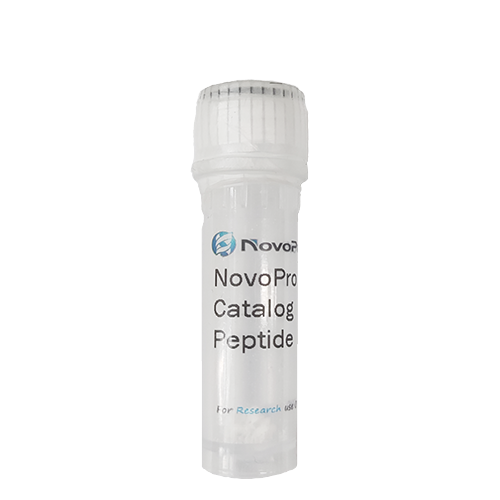Parstatin(mouse) peptide
Not For Human Use, Lab Use Only.
Cat.#: 319832
Special Price 429.00 USD
-
Product Name
Parstatin(mouse) peptide
-
Documents
Batch to batch variation of the purity
-
Sequence Shortening
H-MGPRRLLIVALGLSLCGPLLSSRVPMSQPESERTDATVNPR-OH
-
Sequence
H-Met-Gly-Pro-Arg-Arg-Leu-Leu-Ile-Val-Ala-Leu-Gly-Leu-Ser-Leu-Cys-Gly-Pro-Leu-Leu-Ser-Ser-Arg-Val-Pro-Met-Ser-Gln-Pro-Glu-Ser-Glu-Arg-Thr-Asp-Ala-Thr-Val-Asn-Pro-Arg-OH
-
Length (aa)
41
-
Peptide Purity (HPLC)
95.36%
-
Molecular Formula
C189H326N58O57S3
-
Molecular Weight
4419.14
-
Source
Synthetic
-
Form
Powder
-
Description
Parstatin(mouse) is a 41-amino acid peptide cleaved from the N-terminal extracellular domain of protease-activated receptor 1 (PAR1) upon thrombin activation. This hydrophobic peptide exhibits cell-penetrating properties, enabling intracellular activity. Parstatin(mouse) shares 78% sequence identity with human parstatin in its N-terminal hydrophobic domain, which is critical for its biological function.
Studies demonstrate parstatin(mouse) modulates endothelial cell behavior by inhibiting extracellular signal-regulated kinase (ERK) phosphorylation, inducing cell cycle arrest and promoting caspase-dependent apoptosis. While exhibiting similar mechanisms to human parstatin, the mouse variant shows reduced potency in angiogenesis inhibition assays, suggesting species-specific functional differences. The peptide's hydrophobic region facilitates membrane interaction and cellular uptake, while its hydrophilic C-terminal domain appears less conserved across species.
-
Storage Guidelines
Normally, this peptide will be delivered in lyophilized form and should be stored in a freezer at or below -20 °C. For more details, please refer to the manual: Handling and Storage of Synthetic Peptides
-
References
- Zania P, Gourni D, Aplin AC, Nicosia RF, Flordellis CS, Maragoudakis ME, Tsopanoglou NE. Parstatin, the cleaved peptide on proteinase-activated receptor 1 activation, is a potent inhibitor of angiogenesis. J Pharmacol Exp Ther. 2009 Feb;328(2):378-89. doi: 10.1124/jpet.108.145664. Epub 2008 Nov 6. PMID: 18988770.
-
About TFA salt
Trifluoroacetic acid (TFA) is a common counterion from the purification process using High-Performance Liquid Chromatography (HPLC). The presence of TFA can affect the peptide's net weight, appearance, and solubility.
Impact on Net Weight: The TFA salt contributes to the total mass of the product. In most cases, the peptide content constitutes >80% of the total weight, with TFA accounting for the remainder.
Solubility: TFA salts generally enhance the solubility of peptides in aqueous solutions.
In Biological Assays: For most standard in vitro assays, the residual TFA levels do not cause interference. However, for highly sensitive cellular or biochemical studies, please be aware of its presence.
-
Molar Concentration Calculator
-
Dilution Calculator
-
Percent Concentration Calculator
Mass (g) = Concentration (mol/L) × Volume (L) × Molecular Weight (g/mol)
Related Products / Services
• Peptide Services: NovoPro's peptide synthesis services include standard chemical peptide synthesis, peptide modification, peptide libraries, and recombinant peptide expression.
• Standard Peptide Synthesis: NovoPro offers quality peptides at the most competitive prices in the industry, starting at $3.20 per amino acid. NovoPro provides PepBox – Automatic Quote Tool for online price calculation.
• Peptide Modifications: NovoPro offers a wide range of peptide modification services including isotope labeling (2H, 15N, and 13C), multiple disulfide bonds, multiple phosphorylations, KLH, BSA, ovalbumin, amidation, acetylation, biotin, FITC, etc.
Please note: All products are "FOR RESEARCH USE ONLY AND ARE NOT INTENDED FOR DIAGNOSTIC OR THERAPEUTIC USE"

